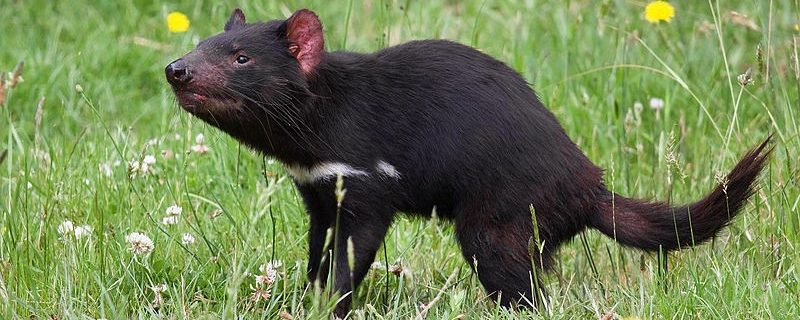By Emily Matcham
Devil Facial Tumor Disease (DFTD) is as horrific as it sounds. Classified as a transmissible cancer, the disease, when present in Tasmanian devil populations, can reduce the populations by approximately 80 percent. Tasmanian devils, which are small, carnivorous marsupials native only to Tasmania, are scavengers and are instrumental to the maintenance of the fragile food web of the island. DFTD may not directly affect humans, but studying the mechanisms behind the disease can shed light on how we can cure our own cancers.
Despite its cancerous nature, DFTD spreads through the devil population like an infectious disease. When devils fight over food or mates, they end up biting each other on the face and body. These bites open up gateways for the spread of cancer cells from one individual to the next. Sometimes, the facial tumors can dislodge teeth, making it hard for the devils to scavenge and leading them to starve.
How can a cancer be transmissible in the first place? One likely explanation is the lack of genetic diversity within the Tasmanian devil population. Tasmania is a small island, so devils are unable to emigrate to new habitats. Additionally, poaching and climate change have resulted in the decline of the devil population. Both decreasing numbers and low mobility have caused high rates of inbreeding in the population have reduced opportunities for diversifying the devil genome.
Despite having many genetic similarities, some Tasmanian devils were observed to suddenly recover from DFTD. A study published in Genetics examined this phenomenon called spontaneous tumor regression, or the unassisted shrinking or disappearance of the cancerous tumors. Investigators sequenced the DNA of the tumors from DFTD-infected Tasmanian devils and observed which devils recovered on their own and which devils did not. The scientists identified that devils who recovered from DFTD had a mutation in their DNA that allowed them to express the RASL11A gene, a tumor-suppressing gene. In Tasmanian devil tumors, silenced or lack of RASL11A expression was seen in non-regressed tumors, whereas activated RASL11A expression was seen in regressed tumors.
So why is this discovery important? This finding is consistent with findings from human colon and prostate cancer studies that research RASL11A in humans, implying that the RAS11A may be a possible therapeutic treatment option for Tasmanian devils and humans with certain cancers. Genetic engineering in human cancer research often faces many ethical challenges. However, investigators can learn a lot about human cancers through other animals. Finding parallels between humans and animal models in cancer research extends beyond just the RASL11A gene, and monumental discoveries can benefit both conservationists and the medical field.
References:
About DFTD | Department of Primary Industries, Parks, Water and Environment, Tasmania. (n.d.). Retrieved November 16, 2020, from https://dpipwe.tas.gov.au/wildlife-management/save-the-tasmanian-devil-program/about-dftd
Brüniche-Olsen, A., Jones, M. E., Austin, J. J., Burridge, C. P., & Holland, B. R. (2014). Extensive population decline in the Tasmanian devil predates European settlement and devil facial tumour disease. Biology Letters, 10(11), 20140619. https://doi.org/10.1098/rsbl.2014.0619
Harrison, J. J. (2010). Tasmanian Devil (Sarcophilus harrisii), Tasmanian Devil Conservation Park, Taranna, Tasmania, Australia. Own work. https://commons.wikimedia.org/wiki/File:Sarcophilus_harrisii_taranna.jpg
Margres, M. J., Ruiz-Aravena, M., Hamede, R., Chawla, K., Patton, A. H., Lawrance, M. F., Fraik, A. K., Stahlke, A. R., Davis, B. W., Ostrander, E. A., Jones, M. E., McCallum, H., Paddison, P. J., Hohenlohe, P. A., Hockenbery, D., & Storfer, A. (2020). Spontaneous Tumor Regression in Tasmanian Devils Associated with RASL11A Activation. Genetics, 215(4), 1143–1152. https://doi.org/10.1534/genetics.120.303428
Tasmanian devil | Habitat, Population, Size, & Facts. (n.d.). Encyclopedia Britannica. Retrieved November 16, 2020, from https://www.britannica.com/animal/Tasmanian-devil
